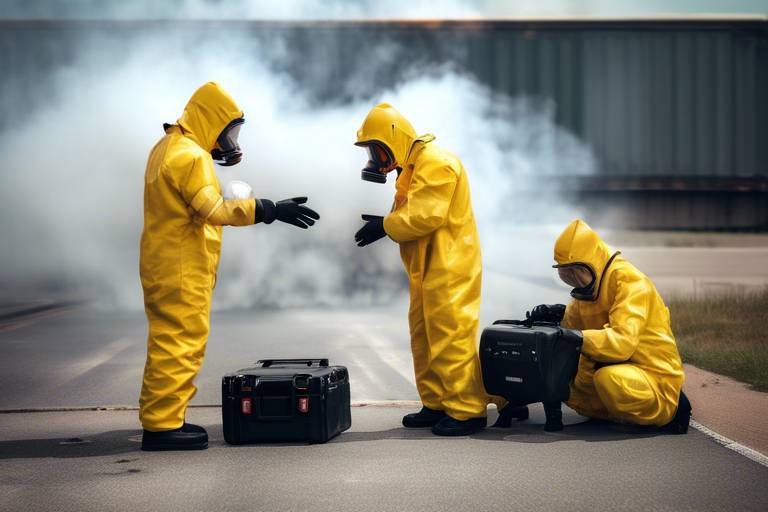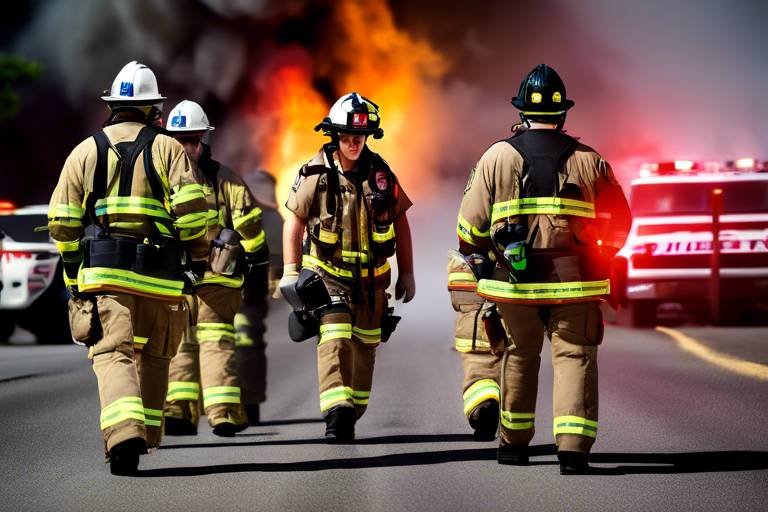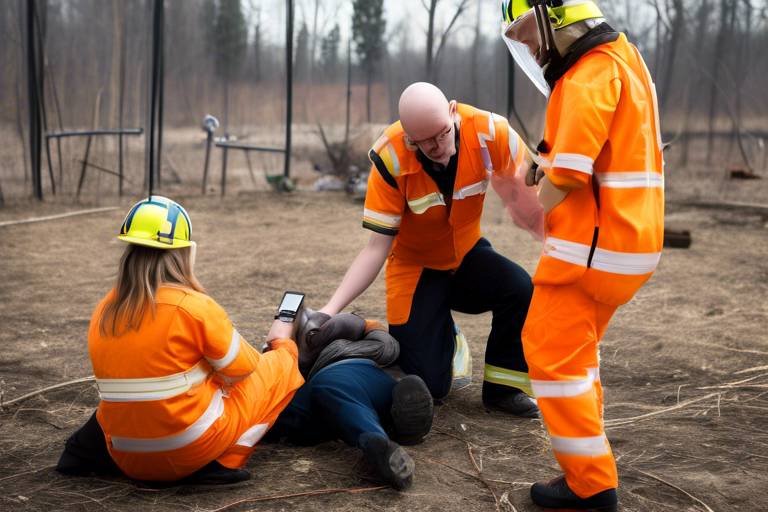Understanding the HazMat Response in Emergencies
When it comes to hazardous materials (HazMat), the stakes are incredibly high. Emergencies involving HazMat can arise unexpectedly, and they often come with serious risks to both public health and the environment. Imagine a chemical spill on a busy highway or a biological threat in a crowded city—these scenarios can escalate quickly, leading to chaos and confusion. That's why understanding the HazMat response is not just important; it's absolutely critical for ensuring safety and minimizing damage.
At its core, HazMat response involves a series of well-coordinated actions designed to address incidents involving dangerous substances. This could mean anything from containing a spill to coordinating evacuations and ensuring that the public is kept informed. The effectiveness of these responses can mean the difference between life and death, not just for those directly involved, but for entire communities.
One of the first things to grasp is that HazMat incidents can be incredibly diverse. They can range from chemical spills that occur in industrial settings to biological threats that could arise from an outbreak of a contagious disease. Each type of incident presents unique challenges that require specific strategies and approaches. For instance, a chemical spill may necessitate immediate containment measures, while a biological threat might require extensive public health interventions.
In addition to the various types of incidents, the roles played by first responders are equally vital. These are the brave individuals who often arrive first on the scene, equipped with training and tools to tackle hazardous situations. Their ability to make quick, informed decisions can significantly influence the outcome of an emergency. Regular training and certification ensure that these responders are always ready to handle whatever comes their way.
Moreover, effective HazMat response is not a solo act. It involves collaboration among multiple agencies, including fire departments, health organizations, and environmental protection agencies. This teamwork is essential for a comprehensive approach to managing HazMat incidents. Without it, the response could be disjointed and ineffective, leading to greater risks and complications.
Public safety measures also play a crucial role in HazMat situations. Clear communication is key; the public must be informed about what is happening, what actions to take, and how to stay safe. This is where community awareness programs and emergency notification systems come into play. By educating the community about HazMat risks and response procedures, we empower individuals to act safely and responsibly during emergencies.
In conclusion, understanding HazMat response in emergencies is about more than just knowing procedures; it's about recognizing the interconnectedness of various elements that contribute to public safety. From the types of incidents to the roles of first responders and the importance of community awareness, every aspect plays a part in creating a safer environment for everyone. So, the next time you hear about a HazMat incident, remember that there's a complex web of actions and strategies at play, all aimed at protecting lives and safeguarding our communities.
- What is a HazMat incident? A HazMat incident involves the release or potential release of hazardous materials that can pose risks to health and safety.
- Who responds to HazMat incidents? First responders, including firefighters, police, and specialized HazMat teams, are typically the first to respond.
- What training do first responders receive? First responders undergo extensive training in HazMat recognition, containment, and safety protocols.
- How can the public stay safe during a HazMat incident? It's crucial to stay informed through emergency notifications and follow guidance from authorities.

The Importance of HazMat Response
Understanding the significance of HazMat response is crucial for minimizing risks to public health and the environment during hazardous material incidents. When hazardous materials are involved, the stakes are incredibly high. A swift and effective response can mean the difference between life and death. Imagine a scenario where a chemical spill occurs near a populated area; without a proper HazMat response, the consequences could be catastrophic. This is why having trained professionals ready to act is not just beneficial—it’s essential.
Effective HazMat response can save lives and mitigate damage. It's like having a well-oiled machine ready to spring into action at a moment's notice. In the chaos of an emergency, responders need to have a clear plan and the right tools to contain the situation. They must assess the risks, determine the best course of action, and implement safety measures to protect both themselves and the public. This requires not only technical knowledge but also the ability to make quick decisions under pressure.
The importance of HazMat response extends beyond immediate safety. It plays a vital role in protecting the environment. For instance, a chemical leak could contaminate groundwater, affecting local ecosystems and drinking water supplies. A well-coordinated response can prevent long-term environmental damage, which is crucial for maintaining a healthy community. To illustrate this point, consider the following table that outlines the potential impacts of inadequate HazMat response:
| Impact | Short-term Consequences | Long-term Consequences |
|---|---|---|
| Human Health | Injuries, illnesses | Chronic health issues, fatalities |
| Environmental | Immediate contamination | Long-lasting ecological damage |
| Economic | Emergency response costs | Loss of property value, increased insurance costs |
Moreover, the ripple effects of a HazMat incident can extend far beyond the immediate area. Communities can suffer economically due to the costs associated with cleanup and recovery. Businesses may close, jobs may be lost, and the local economy can take a significant hit. This is why it is imperative that communities invest in HazMat training and preparedness. By fostering a culture of safety and awareness, communities can reduce the risks associated with hazardous materials.
In conclusion, the importance of HazMat response cannot be overstated. It is a critical component of emergency management that safeguards public health, protects the environment, and ensures the stability of local economies. As we move forward, it is essential to prioritize training, resources, and community awareness to effectively tackle the challenges posed by hazardous materials.
- What is HazMat response? HazMat response refers to the actions taken by trained personnel to manage and mitigate incidents involving hazardous materials.
- Why is HazMat response important? It is vital for protecting public health, the environment, and local economies from the adverse effects of hazardous materials.
- Who are the first responders in HazMat incidents? First responders typically include firefighters, paramedics, and specialized HazMat teams trained to handle dangerous materials safely.
- How can communities prepare for HazMat incidents? Communities can prepare by investing in training, conducting drills, and fostering awareness programs to educate residents about HazMat risks.

Types of HazMat Incidents
Hazardous materials (HazMat) incidents can manifest in a multitude of forms, each posing distinct challenges and requiring specific response strategies. Whether it's a sudden chemical spill in an industrial area or a biological threat that emerges unexpectedly, the nature of the incident dictates the response. Understanding the different types of HazMat incidents is crucial for responders and the community alike, as it informs preparedness and the appropriate actions to take.
One of the most common types of HazMat incidents is chemical spills. These spills can occur in various environments, including factories, transportation routes, and even in laboratories. When a chemical spill occurs, responders must act swiftly to assess the situation. This involves determining the type of chemical involved, the extent of the spill, and the potential risks to both human health and the environment. Quick containment measures are vital to prevent further contamination and protect surrounding areas.
In the world of chemical spills, familiarity with the substances involved is key. Responders need to have a solid understanding of the properties of common hazardous chemicals, such as:
- Acids: Corrosive substances that can cause severe burns and damage to materials.
- Solvents: Often volatile, these can lead to inhalation risks and environmental contamination.
- Gases: Some gases can be toxic or flammable, requiring immediate evacuation of the area.
Each of these chemicals presents unique challenges, and knowing how to handle them can mean the difference between a successful response and a catastrophic failure. Additionally, the health risks associated with chemical exposure cannot be overstated. Exposure can lead to serious health complications such as respiratory issues, skin irritation, or even long-term health effects. Therefore, responders must prioritize their safety by utilizing appropriate protective equipment and following established safety protocols during interventions.
Another significant category of HazMat incidents involves biological threats. These can range from bacterial outbreaks to viral infections that pose a risk to public health. Unlike chemical spills, biological threats often require a different set of response strategies. Understanding how these pathogens spread is crucial for effective management. For example, in the case of an outbreak, responders may need to implement quarantine measures and ensure that proper sanitation protocols are followed to prevent further transmission.
The response to biological threats also involves coordination with health organizations and epidemiologists to assess the situation accurately. This collaboration ensures that the public is informed and that effective containment measures are in place. In such cases, timely communication with the community is vital to prevent panic and ensure that individuals know how to protect themselves.
In summary, the types of HazMat incidents can vary widely, with chemical spills and biological threats being two of the most common. Each requires tailored response strategies and a thorough understanding of the risks involved. By preparing for these incidents, responders can effectively minimize the impact on public health and safety, ensuring that communities are better equipped to handle emergencies.
What are HazMat incidents?
HazMat incidents refer to emergencies involving hazardous materials that can pose risks to health and safety. These can include chemical spills, biological threats, and other dangerous situations.
How can I prepare for a HazMat incident?
Preparation involves being aware of the types of hazardous materials in your area, having an emergency plan in place, and participating in community awareness programs.
What should I do during a HazMat incident?
Stay indoors, avoid the area, and follow the instructions from emergency services. It's essential to remain calm and informed during such incidents.
How are first responders trained for HazMat incidents?
First responders undergo regular training and certification to stay updated on the latest protocols and safety measures for handling hazardous materials effectively.

Chemical Spills
Chemical spills are not just a minor inconvenience; they can escalate into serious emergencies that threaten both human health and the environment. Imagine a bustling city where a truck carrying hazardous materials meets with an accident, spilling its contents onto the road. The chaos that ensues is not just about cleaning up; it’s about swift action, strategic containment, and the safety of everyone in the vicinity. Responders must act quickly to assess the situation, identify the spilled substance, and implement containment measures to prevent further contamination. The clock is ticking, and every second counts!
Responding to a chemical spill involves a series of well-coordinated steps. First, responders must establish a safe perimeter to keep bystanders away from the danger zone. This is crucial as many hazardous materials can have toxic effects, even from a distance. Once the area is secured, the next step is to determine the type of chemical involved. This is where knowledge of common hazardous materials comes into play. For instance, knowing whether the spill involves an acid, a solvent, or a gas can significantly influence the response strategy.
Here’s a quick rundown of the typical response actions:
- Assess the Situation: Quickly gather information about the spill and the chemical involved.
- Establish a Safe Zone: Create a perimeter to protect the public and responders.
- Contain the Spill: Use appropriate materials and methods to prevent the spread of the hazardous substance.
- Notify Authorities: Inform relevant agencies for further assistance and specialized response.
One of the most critical aspects of managing a chemical spill is understanding the properties of the substances involved. For example, volatile substances may require immediate evacuation, while corrosive materials might need neutralization before they can be safely handled. Responders must be equipped with the right personal protective equipment (PPE) to safeguard against potential exposure. This includes gloves, masks, and suits designed to withstand various chemicals.
Moreover, the environmental impact of chemical spills can be devastating. Contaminated soil and water sources can lead to long-term ecological damage. Therefore, responders must not only focus on immediate containment but also plan for environmental remediation. This often involves collaboration with environmental protection agencies to ensure that the affected areas are restored to their natural state.
In summary, chemical spills are complex emergencies that require a well-thought-out response plan. From the initial assessment to the final cleanup, every step is crucial in minimizing risks to public health and the environment. The ability to act quickly and effectively can mean the difference between a contained incident and a full-blown disaster.
- What should I do if I witness a chemical spill?
If you see a chemical spill, immediately move away from the area and call emergency services. Do not attempt to handle the situation yourself.
- How can I prepare for a chemical spill in my community?
Stay informed about local hazardous materials and participate in community awareness programs. Knowing evacuation routes and emergency contacts can be invaluable.
- What are the health risks associated with chemical spills?
Health risks can vary depending on the chemical involved but may include respiratory issues, skin irritation, and long-term health effects from exposure.

Common Chemicals Involved
When it comes to hazardous materials, understanding the in incidents is not just important—it's essential. These chemicals can be found in various settings, from industrial facilities to transportation routes, and their potential dangers can vary significantly. For responders, familiarity with these substances can make all the difference in effectively managing an emergency situation.
Some of the most frequently encountered hazardous chemicals include:
- Acids: These are corrosive substances that can cause severe burns and damage to tissues upon contact. Common examples include sulfuric acid and hydrochloric acid.
- Solvents: Often used in industrial processes, solvents like acetone and toluene can be harmful if inhaled or absorbed through the skin. They often contribute to fire hazards due to their flammable nature.
- Gases: Various gases, including chlorine and ammonia, can pose significant health risks. They may cause respiratory issues, skin irritation, or even more severe reactions, depending on the concentration and exposure duration.
Understanding the properties of these chemicals is crucial for responders. For instance, knowing that acids can react violently with water can help prevent dangerous situations during containment efforts. Additionally, many of these chemicals have specific health risks associated with them, which responders must be prepared to address.
For example, exposure to acids can lead to serious health complications, including:
- Severe skin burns
- Respiratory distress if inhaled
- Long-term damage to internal organs with prolonged exposure
Moreover, the volatility of certain solvents can lead to explosive situations if not handled correctly. Therefore, responders must wear appropriate personal protective equipment (PPE) and follow established safety protocols to minimize risks during their operations.
In summary, a thorough understanding of the common chemicals involved in HazMat incidents is vital for effective response and management. By being aware of the properties and risks associated with these substances, responders can make informed decisions that prioritize safety and efficacy, ultimately protecting both themselves and the public.

Health Risks of Chemical Exposure
When it comes to hazardous materials, the are not something to take lightly. Exposure to harmful chemicals can lead to a range of serious health issues, some of which can manifest immediately, while others may develop over time. It's essential for responders and the public alike to understand these risks to take appropriate precautions. Imagine walking through a field of flowers, only to find out that some of them are actually toxic weeds. That’s the kind of surprise hazardous materials can bring into our lives.
One of the most immediate risks associated with chemical exposure is respiratory problems. Inhalation of toxic fumes can irritate the lungs and airways, leading to symptoms like coughing, wheezing, and shortness of breath. For instance, chemicals like ammonia and chlorine can cause severe respiratory distress, especially in individuals with pre-existing conditions such as asthma. It’s like trying to breathe in a room filled with smoke; the discomfort is immediate and alarming.
Another significant concern is skin irritation. Many hazardous chemicals can cause rashes, burns, or other forms of skin damage upon contact. For example, acids and solvents can lead to severe burns, while prolonged exposure to certain substances can result in dermatitis. Responders must wear appropriate protective gear to shield against these dangers, much like how a knight dons armor before heading into battle.
Moreover, some chemicals have long-term health effects that can be devastating. For example, prolonged exposure to carcinogenic substances can increase the risk of developing cancer later in life. Chemicals such as benzene and formaldehyde are notorious for their links to various cancers. It’s a grim reality that highlights the importance of not just immediate response but also long-term health monitoring for those exposed.
In addition to these physical health risks, there can also be psychological impacts. Experiencing a hazardous materials incident can lead to anxiety, stress, and even post-traumatic stress disorder (PTSD) in some individuals. The fear of potential exposure can linger long after the incident is over, affecting daily life. It’s crucial for responders to be aware of these potential psychological effects and provide support as needed.
To summarize, the health risks associated with chemical exposure are multi-faceted, affecting both the physical and mental well-being of individuals. Understanding these risks is not just about knowing what to avoid; it's about equipping ourselves with the knowledge to protect ourselves and our communities effectively. Here’s a quick overview of the most common health risks:
| Health Risk | Description |
|---|---|
| Respiratory Problems | Irritation of lungs and airways leading to coughing and shortness of breath. |
| Skin Irritation | Rashes and burns from contact with hazardous chemicals. |
| Long-term Health Effects | Increased risk of cancer from prolonged exposure to carcinogens. |
| Psychological Impacts | Anxiety and PTSD from experiencing hazardous incidents. |
In conclusion, awareness and education about the health risks of chemical exposure are vital for both responders and the public. By understanding these risks, we can take proactive steps to safeguard our health and the well-being of our communities.
- What are the symptoms of chemical exposure?
Symptoms can include respiratory issues, skin irritation, headaches, and nausea, depending on the chemical. - How can I protect myself from chemical exposure?
Always wear appropriate protective gear, follow safety protocols, and stay informed about hazardous materials in your area. - What should I do if I suspect chemical exposure?
Seek medical attention immediately and report the incident to local authorities. - Are there long-term effects of chemical exposure?
Yes, some chemicals can lead to chronic health issues, including cancer and respiratory diseases.

Biological Threats
Biological threats are a significant concern in today's world, as they can arise from various sources, including natural outbreaks and deliberate acts of bioterrorism. These threats encompass a wide range of pathogens, such as bacteria, viruses, and toxins, which can cause severe health issues in humans, animals, and even plants. The challenge lies in the fact that these biological agents can be difficult to detect and may spread rapidly, creating a potential public health crisis.
One of the key aspects of responding to biological threats is understanding the transmission methods. Pathogens can be transmitted through various routes, including:
- Airborne transmission: This occurs when infectious agents are carried through the air, allowing them to infect individuals who breathe in contaminated air.
- Direct contact: Many pathogens can be spread through skin contact with an infected person or contaminated surfaces.
- Vector-borne transmission: Some diseases are spread by vectors such as insects, which can carry pathogens from one host to another.
In addition to understanding how these threats spread, responders must also be well-versed in containment protocols. These protocols are designed to minimize exposure and prevent further spread of the biological agent. This includes isolating affected individuals, implementing quarantine measures, and utilizing personal protective equipment (PPE) to safeguard responders and the public.
Moreover, effective communication during a biological threat incident is crucial. Public health officials must relay important information to the community, including symptoms to watch for, preventive measures, and instructions on seeking medical care. This proactive approach not only helps in managing the situation but also builds public trust and encourages cooperation.
Ultimately, the response to biological threats requires a coordinated effort among various agencies, including health departments, emergency responders, and law enforcement. By working together, these teams can ensure a comprehensive and effective response, protecting the community from potential harm while managing the crisis efficiently.
Q1: What are some common biological threats?
A1: Common biological threats include diseases like anthrax, smallpox, Ebola, and various strains of influenza. These pathogens can cause severe illness and have the potential for widespread outbreaks.
Q2: How can communities prepare for biological threats?
A2: Communities can prepare by educating residents about the risks, encouraging vaccination, and developing emergency response plans that include clear communication strategies and coordination with local health authorities.
Q3: What role do first responders play in biological threat incidents?
A3: First responders are often the first line of defense in biological threat incidents. They are trained to assess the situation, implement containment measures, and ensure the safety of both the public and themselves through the use of protective equipment.

Roles of First Responders
First responders are the unsung heroes of any HazMat incident, often arriving at the scene before anyone else. Their presence is crucial because they are trained to assess the situation quickly and implement safety measures that can save lives. Imagine being the first person on the scene of a chemical spill; the decisions you make in those initial moments can mean the difference between chaos and control. These professionals are not just there to manage the immediate crisis; they are also responsible for ensuring that the public remains safe throughout the incident.
To effectively handle hazardous materials, first responders undergo rigorous training and certification processes. This training includes understanding the properties of various hazardous materials, the potential health risks associated with them, and the appropriate response protocols. For instance, if a responder encounters a spill of a toxic chemical, their training allows them to quickly identify the substance and implement containment measures, such as using absorbent materials or creating barriers to prevent further spread. This is where knowledge becomes power—knowing how to act swiftly and decisively can mitigate risks significantly.
Moreover, first responders must also coordinate with other agencies to ensure a comprehensive response. This collaboration can involve fire departments, health organizations, and environmental protection agencies, each bringing their expertise to the table. For example, while firefighters may focus on containment and extinguishing potential fires, health officials can assess the public health implications and recommend evacuations or medical interventions. This teamwork is essential, as it ensures that all aspects of the incident are managed effectively.
In addition to their technical skills, first responders must possess strong communication abilities. They need to relay critical information to the public and other agencies, keeping everyone informed about the situation and any necessary actions to take. Clear communication can prevent panic and confusion, allowing for a more organized response. For instance, during a HazMat incident, responders might utilize emergency notification systems to alert the community about evacuation procedures or safety measures. This proactive approach helps to maintain public trust and encourages cooperation from the community.
Ultimately, the role of first responders in HazMat incidents is multifaceted. They are not only the first line of defense but also serve as educators and coordinators. Their ability to act quickly, communicate effectively, and collaborate with various agencies makes them indispensable in managing hazardous materials emergencies. As we continue to face various HazMat challenges, recognizing and supporting these professionals is essential for ensuring public safety and resilience in our communities.
- What training do first responders receive for HazMat incidents? First responders undergo specialized training programs that cover hazardous material identification, safety protocols, and emergency response procedures.
- How do first responders communicate during a HazMat incident? They utilize radios, emergency notification systems, and public announcements to relay information to the public and coordinate with other agencies.
- What is the importance of coordination among agencies during a HazMat incident? Coordination ensures a comprehensive response, leveraging the expertise of different agencies to effectively manage the situation and protect public safety.

Training and Certification
In the world of hazardous materials, are not just formalities; they are lifelines. First responders face unpredictable situations where the stakes are incredibly high. This is why rigorous training programs are essential. They ensure that responders are not only familiar with the various types of hazardous materials but also equipped with the skills to manage them effectively. Imagine trying to navigate a minefield blindfolded—that's what it feels like to respond to a HazMat incident without adequate training.
First responders undergo a variety of training sessions that cover essential topics, including:
- Identification of Hazardous Materials: Knowing how to identify different types of HazMat can mean the difference between life and death.
- Containment and Cleanup Procedures: Responders learn how to contain spills and safely clean up hazardous materials.
- Personal Protective Equipment (PPE): Understanding how to properly use PPE is crucial for personal safety during an incident.
Certification programs are typically overseen by national and local agencies, ensuring that all responders meet a standardized level of competency. These certifications often require a combination of classroom instruction, hands-on training, and practical assessments. For example, the Hazardous Materials Technician Certification is a widely recognized credential that signifies a responder's ability to handle HazMat incidents effectively. This certification not only enhances the responder's knowledge but also boosts community confidence in their capabilities.
Moreover, continuous education is vital in this field. As new materials and technologies emerge, so too must the knowledge of those tasked with managing hazardous situations. Regular refresher courses and advanced training sessions help keep skills sharp and knowledge up-to-date. Think of it as a mechanic who must stay current with the latest automotive technologies; without ongoing education, even the best responders risk becoming obsolete.
Ultimately, the goal of training and certification is to create a well-prepared workforce capable of responding to HazMat incidents swiftly and effectively. This preparation not only protects the lives of the responders but also safeguards the communities they serve. In a world where hazardous materials are an ever-present reality, investing in training and certification is a commitment to public safety and environmental protection.
Q1: How often do first responders need to renew their HazMat certification?
A1: Certification renewal typically occurs every 3-5 years, depending on the specific requirements set by the certifying agency.
Q2: What types of training do first responders receive for HazMat incidents?
A2: First responders receive training on identifying hazardous materials, containment procedures, personal protective equipment, and emergency response protocols.
Q3: Are there specific certifications for different types of HazMat incidents?
A3: Yes, there are various certifications tailored to specific types of HazMat incidents, including chemical, biological, and radiological response courses.
Q4: How can community members prepare for potential HazMat incidents?
A4: Community members can participate in local training programs, stay informed about HazMat risks, and familiarize themselves with emergency response plans.

Coordination with Other Agencies
When it comes to responding to hazardous materials (HazMat) incidents, coordination with other agencies is not just beneficial; it’s absolutely essential. Imagine a chaotic scene where a chemical spill has occurred. The fire department arrives first, but they're not equipped to handle the specific toxic substances involved. This is where the importance of collaboration shines through. By having a well-defined coordination plan, various agencies can share resources, expertise, and manpower, ensuring a swift and effective response.
First responders, including firefighters, police, and emergency medical personnel, must work hand-in-hand with specialized HazMat teams and environmental protection agencies. Each entity brings unique skills and knowledge to the table. For instance, while firefighters are trained to handle fires and rescue operations, HazMat teams are experts in identifying and mitigating chemical hazards. This synergy is crucial for minimizing risks and protecting public health.
Moreover, the coordination extends beyond immediate responders. Local health departments play a vital role in assessing the health impacts of HazMat incidents on the community. They can provide crucial information on evacuation protocols and health advisories, helping to keep the public informed and safe. Additionally, environmental agencies can assist in evaluating the long-term effects of hazardous material exposure on the environment, ensuring that remediation efforts are effective and sustainable.
To facilitate this coordination, regular training exercises and drills are essential. These simulations allow different agencies to practice their roles in a controlled environment, fostering teamwork and communication. When agencies understand each other's capabilities and limitations, they can operate more efficiently during real emergencies.
| Agency | Role in HazMat Response |
|---|---|
| Fire Department | Initial response, containment, and rescue operations. |
| HazMat Team | Assessment of hazardous materials and implementation of decontamination procedures. |
| Police Department | Securing the area, crowd control, and facilitating evacuation. |
| Health Department | Public health advisories and monitoring health impacts. |
| Environmental Agency | Long-term environmental assessment and cleanup efforts. |
In conclusion, the coordination with other agencies during HazMat incidents is not just about sharing responsibilities; it’s about ensuring a comprehensive approach to public safety. When agencies collaborate effectively, they can manage hazardous situations more efficiently, thereby safeguarding the community and the environment. This interconnectedness is the backbone of effective emergency management, and it’s vital for the well-being of everyone involved.
- What is a HazMat incident? A HazMat incident involves the release of hazardous materials that can pose risks to public health and the environment.
- Who are the first responders in a HazMat situation? First responders typically include firefighters, police officers, and emergency medical personnel who are trained to handle such emergencies.
- Why is coordination important during a HazMat response? Coordination ensures that all agencies involved can share resources and expertise, leading to a more effective response and minimizing risks.
- What types of training do responders receive for HazMat incidents? Responders undergo specialized training that covers identification of hazardous materials, safety protocols, and decontamination procedures.

Public Safety Measures
When it comes to hazardous materials (HazMat) incidents, are not just important—they are absolutely critical. Think of it this way: in a world where dangers lurk around every corner, having a solid plan in place is like having a safety net that catches you before you fall. Clear communication and effective evacuation plans are essential in protecting communities from potential harm. Imagine a scenario where a chemical spill occurs in a busy urban area; without proper safety measures, chaos can ensue, leading to panic and confusion. That's why it's vital to have structured protocols that guide both responders and the public.
One of the key components of public safety during HazMat incidents is effective communication. This involves not only alerting people to the danger at hand but also providing them with clear instructions on what to do next. For instance, during a chemical leak, authorities might issue a warning through various channels, including social media, local news outlets, and emergency alert systems. This multi-faceted approach ensures that the message reaches as many people as possible, minimizing the risk of exposure. Imagine receiving a text alert on your phone that tells you to stay indoors and seal your windows. This kind of prompt action can save lives.
Additionally, having a robust evacuation plan is crucial. In the event of a HazMat incident, knowing where to go and how to get there can make all the difference. Communities should conduct regular drills that simulate HazMat emergencies, allowing residents to familiarize themselves with evacuation routes and safe zones. These drills are not just for show; they help build community resilience and ensure that everyone knows what to do when the unexpected happens. Think of it as a fire drill, but tailored to the unique challenges posed by hazardous materials.
Furthermore, community awareness programs play a significant role in public safety. By educating residents about the risks associated with hazardous materials and the appropriate response procedures, communities become better prepared to handle emergencies. These programs can include workshops, informational pamphlets, and even school-based initiatives. The goal is to empower individuals to act safely and effectively during a crisis. After all, when everyone knows what to do, the community as a whole becomes stronger.
To illustrate the importance of these measures, consider the following table, which outlines various public safety initiatives and their benefits:
| Safety Initiative | Benefits |
|---|---|
| Emergency Notification Systems | Timely alerts to the public, facilitating quick responses. |
| Community Drills | Enhances preparedness and reduces panic during actual incidents. |
| Public Education Programs | Increases awareness and equips individuals with knowledge on HazMat risks. |
Finally, implementing robust emergency notification systems is essential for ensuring that communities receive timely alerts during HazMat incidents. These systems can include text alerts, social media updates, and even sirens that notify residents of impending danger. The quicker the public is informed, the faster they can take action to protect themselves and their families. In a world where seconds can make a significant difference, having a reliable notification system is like having a trusted friend who warns you of an approaching storm.
- What should I do during a HazMat emergency? Always follow the instructions provided by local authorities and emergency services. Stay informed through reliable sources.
- How can I prepare my family for a HazMat incident? Create an emergency plan that includes evacuation routes and communication strategies. Ensure everyone knows what to do and where to go.
- Are there community resources for HazMat education? Yes, many local organizations offer workshops and informational sessions to educate the public about HazMat risks and safety measures.

Community Awareness Programs
Community awareness programs are vital in enhancing public understanding of hazardous materials (HazMat) and the potential risks associated with them. These programs serve as a bridge between emergency responders and the community, ensuring that residents are not only informed but also prepared to respond effectively in the event of a HazMat incident. Imagine living in a neighborhood where everyone knows what to do when a chemical spill occurs; that level of preparedness can make all the difference in minimizing panic and ensuring safety.
One of the key aspects of these programs is education. Through workshops, seminars, and informational pamphlets, community members can learn about:
- Identifying hazardous materials in their vicinity
- Understanding the signs of a HazMat emergency
- Knowing the proper steps to take during an incident
Moreover, these programs often involve hands-on training sessions where participants can practice emergency response techniques. This practical experience not only boosts confidence but also empowers individuals to act decisively in a crisis. For instance, community drills simulate HazMat scenarios, allowing residents to familiarize themselves with evacuation routes and emergency contacts, which can be crucial during an actual event.
Collaboration with local schools, businesses, and non-profit organizations can amplify the reach and impact of these programs. Schools can incorporate HazMat awareness into their curriculum, teaching children the importance of safety and preparedness from a young age. Businesses can host workshops for employees, ensuring that everyone understands their role in maintaining a safe workplace. Non-profits can help facilitate community events, bringing people together to learn and share experiences.
In addition to education and training, effective communication is essential. Community awareness programs should utilize multiple platforms to disseminate information, including:
- Social media campaigns
- Local news outlets
- Community bulletin boards
By leveraging these channels, communities can ensure that information reaches a broad audience, fostering a culture of safety and preparedness. Ultimately, the goal is to create an informed public that can respond appropriately to HazMat incidents, thereby reducing risks and enhancing overall community resilience.
Q1: What is a HazMat incident?
A HazMat incident refers to any situation involving the release or potential release of hazardous materials that pose a risk to health, safety, or the environment.
Q2: How can I prepare for a HazMat incident?
Preparation involves understanding the types of hazardous materials in your area, knowing emergency contact numbers, and participating in community awareness programs to learn response procedures.
Q3: Who should I contact during a HazMat emergency?
In the event of a HazMat emergency, contact local emergency services immediately. They are trained to handle such incidents and can provide guidance on what to do next.
Q4: Are there any resources available for more information on HazMat safety?
Yes, numerous resources are available, including government websites, local emergency management agencies, and community organizations that focus on safety and preparedness.

Emergency Notification Systems
In the realm of hazardous materials (HazMat) incidents, timely communication is paramount. This is where (ENS) come into play. These systems are designed to deliver critical information rapidly to the public, ensuring that individuals are informed about potential dangers and the necessary actions to take. Imagine being in a situation where a chemical spill occurs nearby; the seconds that tick by can feel like hours. An effective ENS can mean the difference between safety and catastrophe.
ENS can utilize various channels to disseminate information, including text messages, emails, social media alerts, and even sirens. This multi-faceted approach ensures that the message reaches as many people as possible, regardless of their preferred communication method. For instance, during a HazMat incident, notifications might include instructions on evacuation routes, shelter-in-place orders, or updates on the situation as it unfolds. The clarity and speed of these messages can significantly influence public response and safety.
Moreover, the integration of geographical information systems (GIS) into ENS enhances their effectiveness. By mapping out affected areas, responders can target notifications to specific locations, ensuring that only those in danger receive alerts. This not only prevents unnecessary panic but also allows for a more organized response. For example, if a hazardous material is released into a river, those living downstream would receive immediate alerts, enabling them to take precautionary measures.
To further illustrate the importance of ENS, consider the following table that outlines key features of effective emergency notification systems:
| Feature | Description |
|---|---|
| Speed | Messages must be sent out quickly to ensure timely warnings. |
| Accessibility | Information should be available via multiple platforms (SMS, email, social media). |
| Targeting | Ability to send alerts to specific geographic areas affected by the incident. |
| Clarity | Messages must be clear and concise to avoid confusion during emergencies. |
| Feedback Mechanism | Allow the public to report their status or ask questions, enhancing community engagement. |
It's also vital to conduct regular tests and drills of these systems to ensure they function correctly when needed. Community engagement plays a crucial role here; residents should be encouraged to sign up for notifications and participate in drills. This not only familiarizes them with the system but also builds a culture of preparedness. After all, in the face of an emergency, knowledge is power, and being informed can save lives.
In conclusion, Emergency Notification Systems are a critical component of HazMat response strategies. They serve as the lifeline between emergency responders and the public, ensuring that vital information flows swiftly and effectively. By investing in robust ENS, communities can enhance their resilience against hazardous materials incidents, ultimately safeguarding lives and property.
- What is an Emergency Notification System? - An ENS is a communication system designed to alert the public about emergencies, providing vital information and instructions.
- How can I sign up for emergency notifications? - Residents can typically sign up through local government websites or emergency management agencies.
- What types of incidents do these systems cover? - ENS can cover various incidents, including natural disasters, chemical spills, and other public safety threats.
- Are there tests conducted for these systems? - Yes, regular tests and drills are essential to ensure the systems function correctly during actual emergencies.
Frequently Asked Questions
- What is a HazMat incident?
A HazMat incident refers to any situation involving hazardous materials that pose a risk to health, safety, or the environment. This can range from chemical spills to biological threats, requiring specialized response efforts to manage the situation effectively.
- Why is HazMat response important?
HazMat response is crucial because it helps minimize risks to public health and the environment during hazardous material incidents. A swift and effective response can save lives, prevent further contamination, and mitigate damage to the community.
- What types of HazMat incidents are there?
HazMat incidents can vary widely, including chemical spills, biological threats, and radiological emergencies. Each type of incident presents unique challenges and requires tailored response strategies to ensure safety and effectiveness.
- What are common health risks associated with chemical exposure?
Exposure to hazardous chemicals can lead to serious health risks, including respiratory problems, skin irritation, and long-term health effects. Responders must prioritize safety and use appropriate protective equipment to minimize these risks.
- How are first responders trained for HazMat incidents?
First responders undergo regular training and certification programs to ensure they are equipped with the latest knowledge and skills necessary to handle HazMat incidents safely and effectively. This training includes understanding hazardous materials, safety protocols, and emergency response techniques.
- What role do agencies play in HazMat response?
Effective HazMat response often requires collaboration among various agencies, including fire departments, health organizations, and environmental protection agencies. This coordination ensures a comprehensive approach to managing hazardous situations and protecting public safety.
- How can communities prepare for HazMat incidents?
Communities can prepare by participating in awareness programs that educate residents about HazMat risks and response procedures. Additionally, having robust emergency notification systems in place allows for timely alerts during incidents, facilitating quick responses to ensure safety.



















